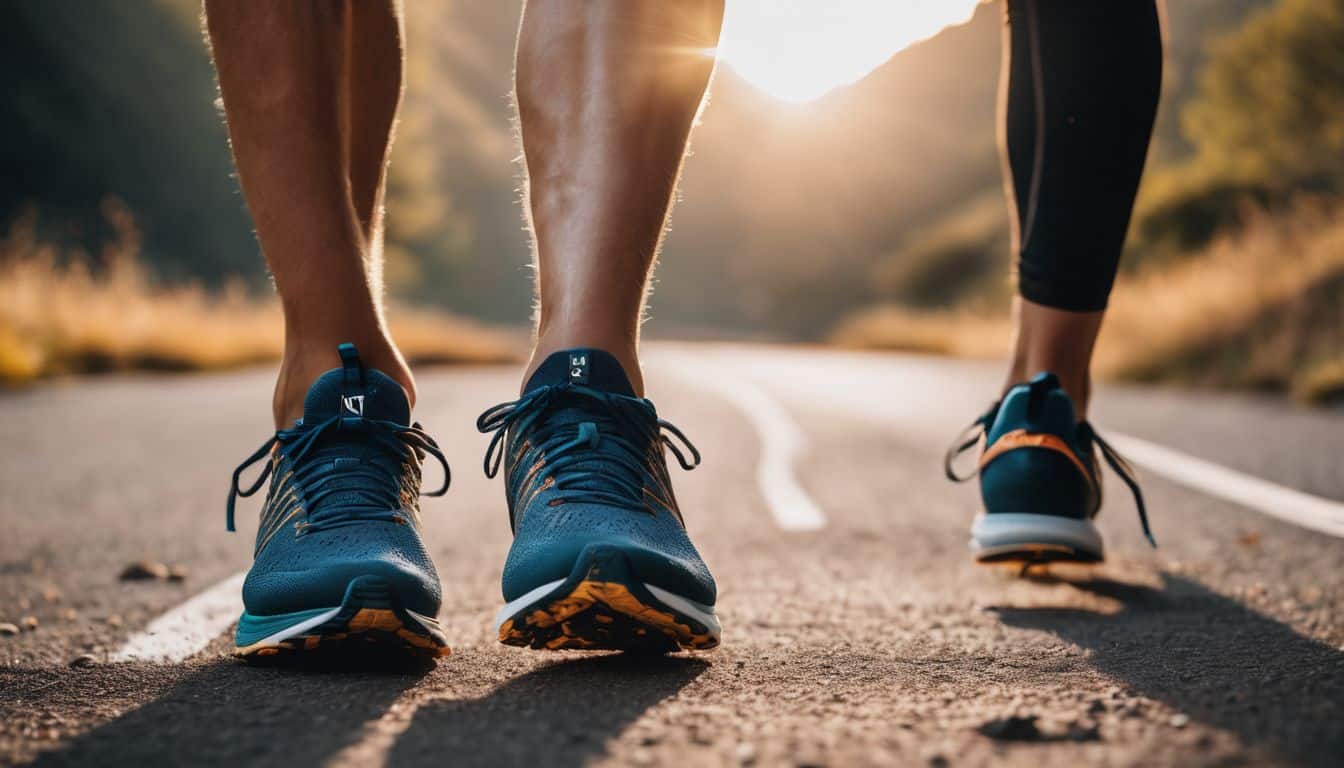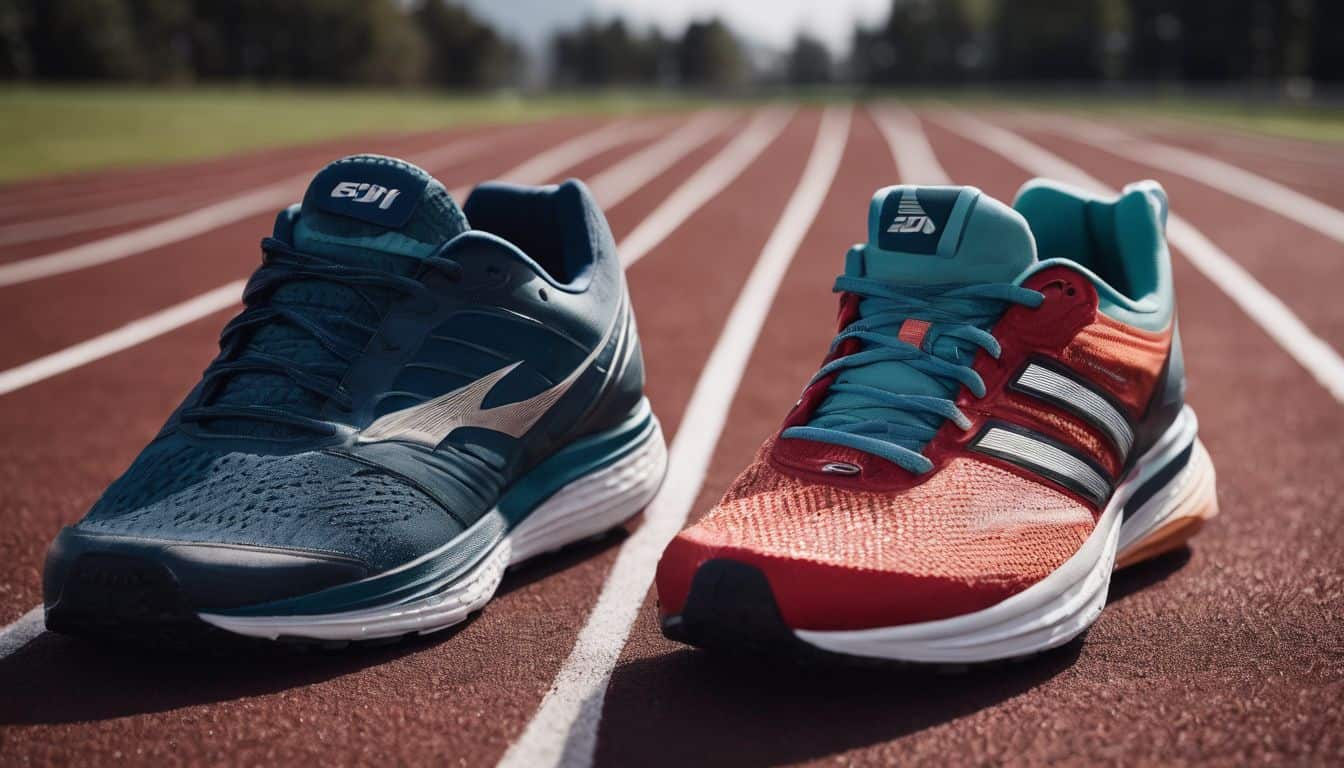Choosing the perfect pair of shoes for walking can feel a bit like navigating through a maze – should you opt for running shoes or training ones? Trust me, it’s not just you wrestling with this conundrum.
With so many factors on the table to consider: cushioning, stability, comfort and countless others – selecting just-the-right footwear can appear quite overwhelming. That’s exactly why I’ve whisked up this comprehensive guide: to help you cut through the noise and decide whether running or training shoes would be your best stride-mates for those walks.
Let’s take a plunge together!
Key Takeaways
- Running shoes have more cushioning and flexibility, making them suitable for running rather than walking.
- Walking shoes provide stability and support, with a stiffer sole to help maintain proper foot alignment during walks.
- Consider factors such as arch support, sole design, and breathability when choosing shoes for walking.
- Choosing the right shoes for walking can reduce the risk of injury, improve comfort, and enhance performance.
Differences Between Running Shoes and Training Shoes for Walking
Running shoes and training shoes for walking have differences in cushioning, flexibility, heel height, stability, and comfort.
Cushioning
Running shoes have more padding than walking shoes. They are built to take in the shock when you run. The heel and forefoot get the most cushion for running. This is where your foot hits the ground first when you run.
Most times, running shoe makers tell people about their air cushion systems. But it’s not the same with walking shoes. Walking shoes don’t need as much padding. The sole of a walking shoe bends and blends more than a running shoe does.
Flexibility
Running shoes have more bend. They let feet move in a natural way. Walking shoes are stiff and give firm support to your foot while walking. The springy feel in running shoes comes from their flexibility.
This helps with each step you take.
A shoe that bends well is good for walking fast or even running. Still, it’s important not to ignore stiffness and support when picking a shoe for walks. You need balance between flex, comfort and shock absorption for the best walk experience.
Heel Height
Running shoes have a high heel stack height. This gives you extra cushion and keeps your foot steady when it hits the ground. But, walking shoes are different. They don’t have a big heel because walkers do not need as much padding.
This is called the “heel drop.” It’s lower in walking shoes than running ones. You will also find that running shoes come with different types of support built in for various heel heights.
Be careful though, if the drop is too high, it can cause more stress on your hips and knees! If it’s too low, then feet, ankles and legs might feel strained.
Stability
Stability is an important factor to consider when choosing shoes for walking. Running shoes typically have a higher heel stack height, which provides added stability during heel strikes.
On the other hand, walking shoes have a more built-up heel that offers less cushioning and stability compared to running shoes. In addition, running shoes often have a stiffer sole for better support and reduced pronation and leg rotation.
Walking shoes, on the other hand, prioritize flexibility over sole stiffness. It’s worth noting that walking shoes are usually heavier than running shoes to maintain stability while walking.
Comfort
Comfort is a crucial factor to consider when choosing the right shoes for walking. When it comes to comfort, running shoes and training shoes may have some differences that you should be aware of.
Running shoes typically provide more cushioning, which can help absorb the impact of each step and reduce discomfort during long walks. On the other hand, walking shoes tend to be stiffer than running shoes, providing stability and support for your feet.
However, it’s important to note that thicker heel wedges in running shoes may cause issues and discomfort when walking. So, when selecting your walking footwear, remember that seeking expert advice is essential to ensure maximum comfort throughout your walking sessions.
Factors to Consider When Choosing Shoes for Walking
When choosing shoes for walking, it’s important to consider factors such as arch support, sole design, and breathability.
Arch Support
Arch support is crucial when choosing shoes for walking or running, especially if you have medium to high arches. It helps maintain proper foot alignment and prevents injuries. People with low or high arches are more prone to getting hurt, so they should look for shoes that offer additional support and stability.
The arch support in your shoes needs to be positioned correctly to give optimal support and align your foot’s arch properly. If you have flat feet or high arches, you might need custom arch supports or orthotics for extra support and to alleviate any discomfort or pain.
Having good arch support in your shoes can also help distribute pressure evenly across your foot, reducing the risk of conditions like plantar fasciitis or shin splints.
Sole Design
When choosing shoes for walking, the sole design is an important factor to consider. The sole should provide support and stability while also being flexible enough to allow natural foot movement.
It should have good traction to prevent slipping and help maintain stability during walks. The sole should also have sufficient cushioning to absorb shock and reduce the impact on joints, which can help prevent injuries.
Additionally, the thickness and design of the sole can affect the weight and flexibility of the shoe, so finding a balance that suits your needs is crucial. Considering these factors will ensure that you choose walking shoes with a sole design that meets your requirements for comfort and performance.
Breathability
Breathability is an important factor to consider when choosing shoes for walking. It refers to how well the shoes allow air to flow in and out, keeping your feet cool and dry. When you’re walking or running, your feet can get sweaty, so having shoes that are breathable can help prevent discomfort and blisters.
Look for shoes with mesh or perforations on the upper part of the shoe, as this allows for better ventilation. Breathable shoes also help with moisture-wicking, which means they can draw sweat away from your feet and promote evaporation.
So remember, when choosing shoes for walking, prioritize breathability to ensure comfort during your workouts!
Benefits of Choosing the Right Shoes for Walking

Choosing the right shoes for walking offers a reduced risk of injury, improved comfort, and enhanced performance.
Reduced Risk of Injury
Choosing the right shoes for walking can greatly reduce the risk of injury. When we wear shoes that are specifically designed for walking, we minimize the chance of harm during our walks or runs.
If our shoes are not appropriate for the activity or don’t match our body mass and foot shape, there’s a higher likelihood of getting hurt. That’s why it’s so important to select footwear that provides stability, cushioning, and flexibility.
By opting for the proper shoes, we ensure smooth walking movements and decrease the chances of getting injured while enjoying our exercise routine. Regularly replacing worn-out walking shoes is also crucial to maintain optimal support and prevent injuries from occurring in the long run.
Improved Comfort
Having improved comfort is crucial when it comes to choosing the right shoes for walking. Walking shoes should feel good and comfortable from the moment you put them on. This means that they should provide immediate comfort and alleviate any foot pain or discomfort.
With the right pair of shoes, you can prevent foot health problems like blisters, calluses, and plantar fasciitis. So, prioritize comfort when selecting your walking shoes to ensure an enjoyable and pain-free experience while walking or running.
Enhanced Performance
Choosing the right shoes for walking can greatly enhance your performance. When you have the optimal footwear, you’ll experience improved walking performance and increased comfort and support.
This is because the right shoes provide cushioning and stability, which help reduce the risk of injury while providing maximum comfort. Proper shoe selection has a significant impact on your overall foot health, preventing foot and ankle issues that could hinder your performance.
So, by choosing the correct shoes for walking, you’re not only taking care of your feet but also ensuring enhanced performance during your walks.
Detailed Guide: Should I Get Running Or Training Shoes For Walking
As a running enthusiast, I understand the importance of choosing the right shoes for walking. Here’s a detailed guide to help you decide whether to get running shoes or training shoes for your walking workouts:
- Running shoes are often a better option for fitness walkers than shoes specifically marketed as walking shoes.
- Running shoes have a stiffer sole, which provides more support and stability during high – impact activities like running.
- Walking shoes, on the other hand, have more flexibility and blend to accommodate the natural movement of your feet while walking.
- Running shoes usually have thick heel wedges that provide extra cushioning and shock absorption compared to walking shoes.
- It’s important to consider the type of activity and its impact on your feet when choosing between running or training shoes for walking.
Conclusion on Should I Get Running Or Training Shoes For Walking
In conclusion, when deciding between running or training shoes for walking, it’s important to consider the specific demands of your activity. While running shoes can offer cushioning and support, they may not provide the flexibility and stability needed for walking.
On the other hand, training shoes may be heavier but offer better durability and versatility. Ultimately, it’s best to choose shoes that are specifically designed for walking to ensure optimal comfort and reduce the risk of injury.
Are the Benefits of Cross-Country Skiing Similar to Those of Running for Cross Training?
Cross-country skiing offers powerful benefits of cross-country skiing, similar to running, for cross-training. Both activities engage multiple muscle groups, leading to improved cardiovascular fitness and endurance. However, skiing places less stress on joints than running, making it a low-impact alternative. Additionally, skiing challenges balance and coordination while providing a full-body workout. Give this winter sport a try for versatile cross-training advantages.
FAQs on Should I Get Running Or Training Shoes For Walking
1. Can I use running shoes for walking?
Yes, you can use running shoes for walking as they provide cushioning and support for your feet.
2. What are the benefits of using training shoes for walking?
Using training shoes for walking can offer more stability and lateral support, which is beneficial if you have a tendency to overpronate or need extra balance during your walks.
3. How do I choose between running and training shoes for walking?
Choose running shoes if you prioritize cushioning and shock absorption, while training shoes are a better option if you need additional stability and lateral support.
4. Are there any differences in the design of running and training shoes for walking?
Running shoes typically have more cushioning in the heel area compared to training shoes, which often offer firmer midsole support throughout the shoe.
5. Should I consult with a professional when deciding between running and training shoes for walking?
It’s recommended to consult with a knowledgeable footwear specialist or podiatrist who can assess your individual needs based on your foot type, gait analysis, and any specific concerns you may have.






Leave a Reply